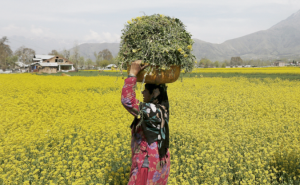Two droughts in a row have caused immense distress in areas like Marathwada. The courts have ordered the Indian Premier League to move its cricket matches out of Maharashtra to conserve water. But this will not improve farm incomes.
Far more relevant would have been the ending of free canal water and free electricity for pumpsets encouraging inappropriate water-guzzling crops like sugarcane. Agriculture accounts for 80% of all water consumption. This can be halved by switching from field-flooding to drip and sprinkler irrigation.
Agriculture accounts for almost half of all employment but only 14% of GDP. India must move people out of agriculture into industry and services. Meanwhile, it must harness the latest technologies to improve farm yields and income.
Many farmers’ organizations have long demanded the approval of genetically modified (GM) crops to raise yields. They have been opposed by various NGOs on pseudo-scientific grounds. Environment minister Prakash Javadekar needs to urgently secure approval for growing GM crops in the interests of both science and farming.
Two weeks ago, six farmer organizations demanded government approval to grow GM mustard, developed by Indian scientists. This will raise yields by 20-30%, and improve farm income by over Rs 1,000 crore. It will also reduce India’s dependence on imported edible oil.
Farmers’ leader Chengal Reddy says GM mustard and GM brinjal could replicate the stunning success of GM cotton. This has revolutionized cotton farming, doubled output and converted India from an importer to a major exporter of cotton. Like all crops, GM cotton needs constant improvement, especially against new pests, but its impact in the last decade has been stunning.
International NGOs like Greenpeace have enormous budgets and now channel millions of dollars into developing countries. Many Indian NGOs now depend critically on such dollar inflows for their jobs and budgets. That’s why they exude passion on western green agendas like GM crops, while saying relatively little about environmental disasters that India actually needs to focus on, like the destruction of aquifers by farmers getting free electricity, and diversion of scarce canal water to water-guzzling crops like sugarcane and paddy at the expense of crops like maize needing much less water.
The NGOs claim GM foods are unsafe. This is flatly disproved by the simple fact that in the US, which grows a wide variety of GM foods, over three trillion meals have been eaten without any adverse consequences. India has long imported and consumed edible oils based on GM soybean and canola. Cotton-seed oil extracted from GM cotton in India is widely consumed. There is not the slightest evidence of any harm.
The activists seek by hook or crook to delay genetically modified crops, using the courts and rented mobs financed partly by dollar inflows. In consequence, they have increased approval time in many western countries to seven years or more, raising the cost of bringing a new GM crop to market to almost $150 million. This means only the biggest companies like Monsanto can afford to stay in the game. Thus the very activists that demonise Monsanto end up strengthening its market domination.
Sharad Joshi, India’s most famous farm leader, used to say that most Indian greens were really “watermelons” — green outside but red inside. Marxists who can no longer sell the idea of the dictatorship of the proletariat have shifted to selling horror stories about GM crops. They claim to have scientific knowledge, but much bogus green “research” on the terrible fate that would hit Indian farmers growing GM cotton turned out to be as fictitious as the worst Stalinist literature.
Norman Borlaug, Nobel Laureate and father of the green revolution, was a great supporter of GM crops. He blasted anti-GM activists as ignorant alarmists spreading falsehoods. “There is no evidence that biotechnology is dangerous.” A top science writer like Matt Ridley has long exposed the anti-GM campaign as hollow.
Dr Patrick Moore, a scientist and founder of Greenpeace, later left that organization in protest against its non-scientific opposition to GM crops. When I last met him, he was seeking funding to prosecute Greenpeace and other NGOs for “crimes against humanity.” He said that depriving farmers and hungry people of the benefits of GM crops was nothing less than a crime against humanity.
So Mr Javadekar, please dump the bogus objections of pseudo-scientific activists, and expedite approval of GM brinjal and mustard. Bangladeshi farmers are already growing GM brinjal, getting higher yields and incomes.
Ordinary brinjal needs 30-35 sprayings of pesticide against just five sprayings for GM brinjal. Pesticide levels in Indian diets are already dangerously high and need to be reduced. For the sake of consumers as well as farmers, let the GM revolution spread fast and wide.



Statistics claim that half of India’s population live on agriculture. The number might be much less or might be including farm workers who are working part time.
However all small peasants and farm workers are on NREGA. All manual jobs other than farm related are also done by these people in villages and towns other than big cities.
Majority of the farm work has been mechanised to a reasonable extent. A recent survey shows population from rural areas get most of the employment from non agrarian activities.